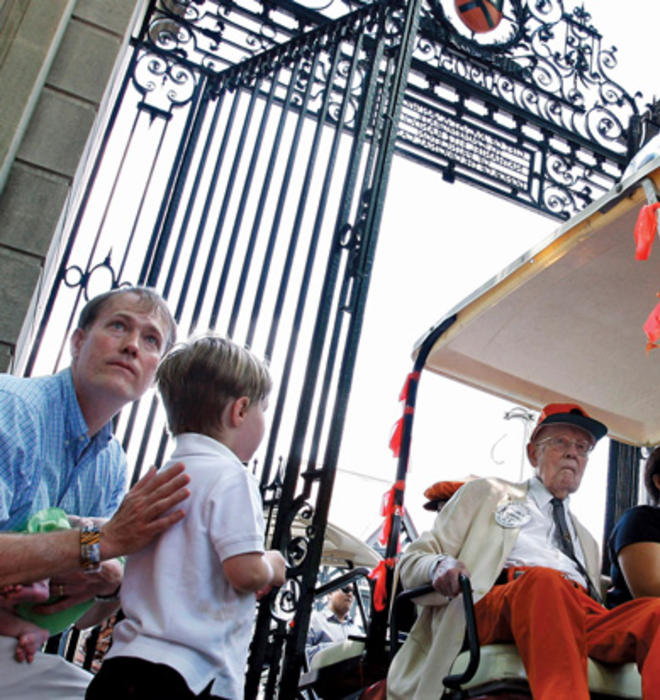
June 21, 1905 – Oct. 9, 2012
The oldest son of Princeton ever, and our last link to the Roaring ’20s, Malcolm Warnock died at age 107. The curtain falls on a legendary era.
A few months before his death, Warnock endured crowds and discomfort to attend his 87th reunion, an almost inconceivable achievement. He clutched the silver cane for the eighth time since 2001, having outlasted not only his entire college class but, University officials believe, everyone in the subsequent five classes as well. Such longevity feels surreal: Warnock’s life overlapped with those of Susan B. Anthony and Mark Twain — and finally with our lives.
Today’s undergrads cannot remember a time without the Internet; Warnock grew up before radio and talking films and bought his first car, a Model A, in 1926. Born on the same day as the philosopher Sartre, he was older than LBJ and JFK. He walked the campus with giants, including Adlai Stevenson ’22.
Warnock grew up in leafy Cranford, N.J., in the idyllic years before World War I. A memoir he wrote at 101 recalls horseback riding and skating, first hearing a phonograph, Sunday drives in a hack. His parents took him by ferry to New York City to visit stern Grampa Warnock, who let him peer through a microscope — the grandfather had founded the New York Microscopical Society in 1877. Warnock inherited a lifelong love of science, including telescopes.
As a high school student, Warnock toured the Scribner’s bindery, which his father managed. That was about 1920, when This Side of Paradise by F. Scott Fitzgerald ’17 was bound there.
Stepping off the Dinky in fall 1921, Warnock hauled his trunk to 16 South Edwards Hall, right above the front door — a location he later would point out from his P-rade golf cart. His major was history; club, Key and Seal; tuition, $700.
“Mal” was assigned to a cavalry honor guard when war hero Marshal Foch visited. Just 16, the freshman struggled to restrain the enormous horse and hold aloft a heavy sword: “The guy on my right said, ‘Hey, watch what you’re doing with that sabre!’”
He sang in the Chapel Choir and played fiddle in the University Orchestra. Sunday afternoons brought organ recitals at the Graduate College: “I remember the setting sun shining through the stained-glass windows. It got me started with a real love of Bach, which has continued all my life.”
Like Fitzgerald scarcely five years earlier, Warnock slipped academically, and after six semesters he transferred to Columbia. Long a lawyer, he retired 40 years ago to devote himself to tennis, painting, and collecting clocks. Of Reunions, he said, “There is nothing like it in this world.”
It was a gift to have him visit us each June, perhaps more than we realized. Born under the 45-star flag, Malcolm Warnock was, quite simply, the last human being most of us will see who drew breath in a pre-modern America.
W. Barksdale Maynard ’88 is the author, most recently, of Princeton: America’s Campus (The Pennsylvania State University Press).
CLICK HERE to watch a video of Malcolm Warnock ’25






No responses yet